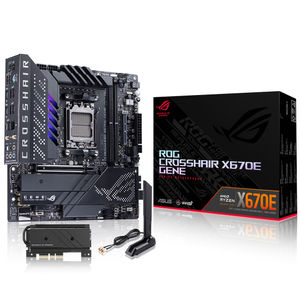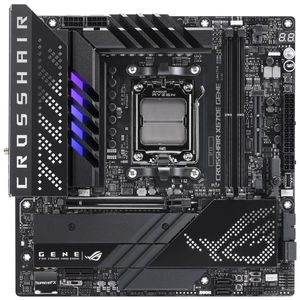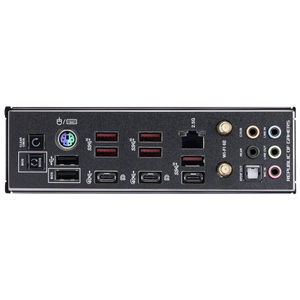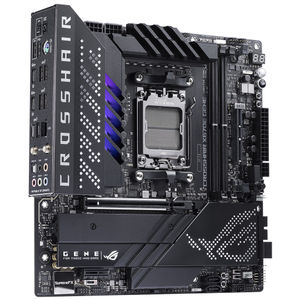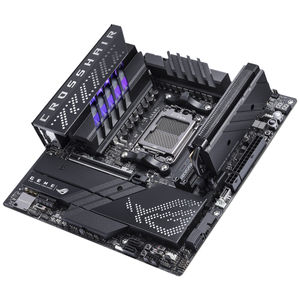ASUS ROG Crosshair X670E Gene DDR5 Motherboard
ROG-CROSSHAIR-X670E-GENE | ASUSThis product has been discontinued
|
Warning: This product contains a button battery - If swallowed, a lithium battery can cause severe or fatal injuries with 2 hours. - Keep batteries out of reach of children. - If you think batteries may have been swallowed or placed inside any of the body, seek immediate medical attention. |
Features
Overview
Formed by splicing the ROG DNA and mixing in an SFF enzyme, the ROG Crosshair X670E Gene is a mATX powerhouse that lets you have it all. With bulked-up power delivery and heatsinks, it dishes up a full-fat serving of AMD Ryzen™ 7000 Series processors, alongside a digestible blend of PCIe 5.0, DDR5, WiFi 6E, and USB4 for enthusiasts that want a compact AM5 build on the desktop.
- Robust 16 + 2 teamed power solution rated for 110A per stage
- Dynamic clocking to simultaneously maximize Ryzen gaming and compute performance
- 6400 MT/s+, AMD EXPO, DRAM IC profiles, and AEMP
- Both the on-board M.2 slot and x16 slot are PCIe Gen 5-ready
- ROG GEN-Z.2 adds a Gen 5 and Gen 4 M.2 slot inside a DIY-friendly heatsink shell
- AI Cooling II uniquely balances noise and thermals for your system with a single click
- Faster-than-Gigabit WiFi that unlocks access to the low-interference 6 GHz band
- Dual USB4 Type-C® ports for up to 40 Gbps bi-directional bandwidth
DIY Friendly
ROG Patented Pre-Mounted I/O Shield ESD Guards
Providing greater electrostatic protection than the industry standard, ESD Guards cover the USB, audio and LAN ports.
Truevolt USB
USB power supplies a rock-steady 5 volts to all USB ports, minimizing power fluctuations for minimal data loss.
Safeslot
Reinforced to protect the motherboard and PCIe expansion card from damage.
M.2 Q-Latch
The innovative Q-Latch makes it easy to install or remove an M.2 SSD without the need for specific tools. The design employs a simple locking mechanism to secure the drive and neatly eliminate traditional screws.
2 x Q-DIMM
One-sided clips for super simple and secure handling of memory modules.
Q-Code
LED panel that shows 2-digit codes to indicate power status and potential problems for quick diagnosis.
Flexkey
At its default, FlexKey functions as a system reset button, but it can also be easily reassigned to quickly turn Aura lighting on or off, activate Safe Boot, or enter the BIOS.
PCIE Slot Q-Release
A physical button unlocks the first PCIe slot’s security latch with one tap, greatly simplifying the process of detaching a PCIe card from the motherboard when it’s time to upgrade to a new GPU or other compatible device.
Q-Connector
Simple adapter that helps arrange front-panel cables in an orderly manner.
Performance
The ROG Crosshair X670E Gene features a sixteen-pack power solution specifically grown to handle the multi-threaded muscle of AMD Ryzen™ 7000 Series processors. Combined with a streamlined DDR5 layout, this nimble powerhouse dishes out hyperspeed performance. And ROG makes it as easy to access its natural edge through a suite of unique software and firmware technologies catering to beginners and veterans alike.
Overclocking
ROG Overclocking Technologies
Take Ryzen beyond the already impressive sum of its parts. Dynamic OC Switcher and Core Flex create additional frequency waypoints for single and multi-threaded workloads, allowing Ryzen to break boundaries and achieve peak performance in all games and apps.
AI Overclocking
Tuning is now faster and smarter than ever before. ASUS AI Overclocking profiles the CPU and cooling to predict the optimal configuration and push the system to its limits. Predicted values can be engaged automatically or used as a launching ground for further experimentation.
Dynamic OC Switcher
Lightly-threaded tasks get fantastic uplift using AMD Precision Boost Overdrive (PBO), but all-core frequencies can be pushed higher via traditional overclocking. The Dynamic OC Switcher lets you use them both, dynamically engaging PBO or your preferred settings based on the CPU current or temperature.
Temp - Current
- Manual OC - Ex: > 35A, < 80° - Multi-Threaded Performance
- AMD PBO - Ex: ≤ 35A, ≥ 80° - Single-Threaded Performance
Example:
If a user sets thresholds for current and temperature as shown, once CPU current exceeds 35A, the manual overclock engages until the temperature reaches 80°. At all other times, Precision Boost Overdrive will be used.
Core Flex
Core Flex empowers you to smash limits farther than ever before by letting you control clock, power, and thermals in creative new ways. In its simplest form, you can maximize base clock during lighter loads and set breakpoints to gradually reduce CPU core frequency as temperature or current increases. But the system is extremely adaptable, supporting multiple user-controlled functions that can manipulate power, current, and temperature limits independently so that you can bend CPU performance to your will.
Temp - Current - Voltage
Max Performance - Medium - Safe & Stable
Examples:
Base Clock
- For this CPU, the base clock (BCLK) can be stably increased to give an extra boost during lightly threaded workloads.
- At Level 1, the BCLK is set to 104, and it remains at that frequency until the current reaches 35A.
- Then the BCLK drops down to 102, and stays in that Level 2 range up until 55A.
- From that point on, the CPU is using most or all of its threads, so the BCLK scales back to the default 100.
EDC
- By managing the Electrical Design Current (EDC) in tandem with the total current, this CPU can gain extra performance for short, demanding bursts.
- During lightly threaded workloads, below 35A, the Level 1 EDC is set to a low value, in this case 60.
- As more cores are needed, the EDC is set to 120, which was found by this user to be a sweet spot for performance.
- Once the CPU passes 70A, it is in multi-threaded territory, where it was found that a high EDC of 250 gave optimal performance.
PPT
- In order to let the CPU cool off if its temperatures go too high, this user constrains the Package Power Target (PPT) when thermals increase. Specifically the short-term value (“Fast”) is used.
- Until the CPU reaches 70°, it can run at full performance, so 350W is set to give plenty of overhead.
- At that point, the power limit reduces to 220W, to let the CPU start reducing heat.
- If it is still under sustained load and keeps getting hotter, then a more stringent 165W PPT is set at 85°.
Asynchronous Clock
For next-level frequency flexibility, the ROG Crosshair X670E Gene features a built-in clock generator that isolates CPU base clock from memory, PCIe, and the Infinity Fabric speed. Drive CPU performance to its absolute brink while maintaining the stability of related clock domains.
- Crystal Oscillator
- Clock Generator
- SoC-Connected Components - iGPU, Memory, Infinity Fabric, NBIO
- CPU Clock - Separate CPU BCLK from other components for a stable overclocking edge
Overclocker’s Toolkit
The ROG Overclocker’s Toolkit is a powerful set of hardware-level controls to enhance your overclocking experience. Some are quick and easy time savers, while others offer masterful functionality to help you smash benchmarks and break records.
Retry Button
Instantly initiates a hard reset with just a press.
Safe Boot Button
Instantly reset the PC and boot directly into Safe mode.
Slow Mode Switch
Reduces the CPU ratio to 8X to keep the system stable during setup for extreme overclocking.
RSVD Switch
Helps the system boot under extreme temperatures (≤ -120°C)
LN2 Mode
Jumper to enable special options and functions for liquid-nitrogen (LN2) overclocking.
Probelt
Includes twelve integrated measurement points for advanced tuning.
BCLK Buttons
Adjust the BCLK frequency to improve system performance.
ROG True Voltician
For truly advanced performance optimization, the ROG Crosshair X670E Gene includes the ROG True Voltician, a miniature oscilloscope that connects to an onboard USB header and displays waveforms for the CPU Vcore, VCCIN, and System Agent rails. It can also be used to monitor a video card or power supply, and users can even run the True Voltician software on one PC while they get readings from another.
PBO Enhancement
AMD Precision Boost Overdrive (PBO) pushes the CPU current and voltage budget to opportunistically increase performance. By aggressively tuning the PBO parameters, AMD’s algorithm can leverage the motherboard’s robust power solution to ramp up performance even higher.
- EDC
- PPT
- TDC
- Fmax
- Scalar
Power Solution
Teamed Power Architecture
Today's CPU architectures place incredible demands on motherboard power design by transitioning from deep power-saving modes, going from lower-power mode to full load in an instant. The latest ROG VRM architecture rises to the challenge by utilizing teamed power stages to rapidly swing current, while maintaining exemplary thermal performance.
A Brief History
ASUS became the first manufacturer to implement phase-doublers with the A8N32-SLI Deluxe motherboard, back in 2005. The board's VRM was lauded for elegantly overcoming the power handling capabilities of components that were available at the time while also reducing voltage ripple. Those benefits led to phase-doublers becoming universally accepted in the industry, and they are still used for similar purposes today.
A Shift in CPU Demands
Modern CPUs pack more cores than their predecessors, and the latest instruction sets allow them to crunch computationally dense workloads at an incredible pace. In addition, they consume less power at idle and can transition between load states much more quickly. These improvements necessitate a re-evaluation of power-design priorities because phase-doublers add a propagation delay that hampers transient response.
While doublers help extend the number of effective phases, they do so at the cost of a processing delay.
Bucking the Trend
Fortunately, the latest integrated power components can handle higher currents than the devices of yesteryear, making it possible to implement a simple circuit topology that isn't hamstrung by the processing lag of phase-doublers. That's why the ROG Crosshair X670E Gene utilizes teamed power stages to deliver higher burst current per phase, while maintaining the thermal performance of phase-doubled designs.
The teamed architecture allows two power stages to work in tandem to provide more power to the CPU.
Thermal Performance
Each VRM component serves a specific purpose. PWM controllers and phase-doublers control the circuit, and the power stages do the heavy lifting from an electrical and thermal standpoint. The power stages feature low RDSON to reduce switching and conduction losses, helping to improve overall thermal headroom.
The MOSFETs within the power stages generate the most heat as they are responsible for voltage conversion and delivery to the CPU from the 12-volt EPS connector.
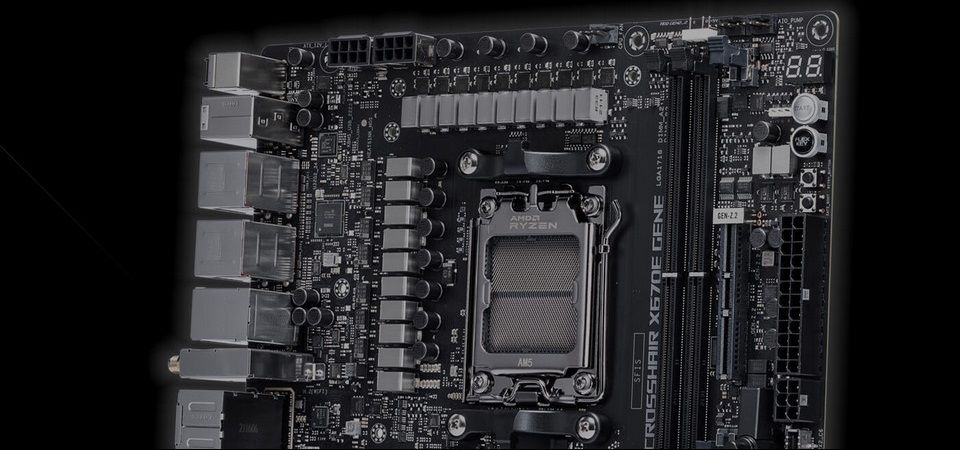
High-Quality Components
8+8 Pins ProCool III Power Connectors
Two ProCool connectors ensure a snug and reliable connection to the EPS 12V power lines
MicroFine Alloy Chokes
Each power stage is accompanied by a high-permeability alloy-core choke rated to handle 45 amps.
16+2 Power Stages
The VRM features 16 +2 power stages, each rated to handle 110 amps.
10K Black Metallic Capacitors
Input and output filtering is provided by solid-polymer capacitors rated to last thousands of hours at high operating temperatures.
Memory
DDR5 Memory
Comprehensive memory tuning options are the cornerstone of ROG motherboards. With the Crosshair X670E lineup, you can extract all of the potential out of your DDR5 modules, regardless of if they're from an extreme-speed kit or an entry-level set that would otherwise be locked.
DDR5 Strength
For those who want to fly past stock DDR5 speeds, the ROG Crosshair X670E Gene is primed and ready for enthusiast-grade kits courtesy of vast AMD EXtended Profiles for Overclocking (EXPO) support. Seasoned veterans can further tweak performance via the extensive array of settings in the UEFI.
AEMP
ASUS Enhanced Memory Profile (AEMP) is an exclusive firmware feature for PMIC-restricted memory modules. AEMP automatically detects the memory chips on your kit and then presents optimized frequency, timing and voltage profiles that you can effortlessly apply to unleash performance.
Cooling
Meeting Ryzen thermal demands head-on, the ROG Crosshair X670E Gene wields hefty VRM, chipset, and M.2 heatsinks to keep everything running at top performance. To aid in airflow, the Gene boasts copious fan header support—a blessing for building in tight spaces. Once the rig is assembled, ROG tools make it easy to monitor and control fan speeds, and with the improved AI Cooling II utility, balancing system acoustics is better than ever.
Heatsinks
Cooler by Design
VRM Heatsinks and Heatpipe
A VRM heatsink on the MOSFETs and chokes is connected to the aluminium I/O cover via an embedded heatpipe to increase mass and surface area for dissipation.
M.2 Heatsink and Backplate
Dedicated heatsinks on the front and back of the M.2 slot ensure that your drive delivers peak performance, even if airflow is restricted.
High-Conductivity Thermal Pads
A high-quality thermal pad improves overall heat transfer from the system by bridging the heat generated by the power stages to the heatsink. For future maintenance, a replacement thermal pad can also be found in the package.
Chipset Heatsink
A dedicated heatsink draws heat away from both chipsets to maintain optimum operating temperature.
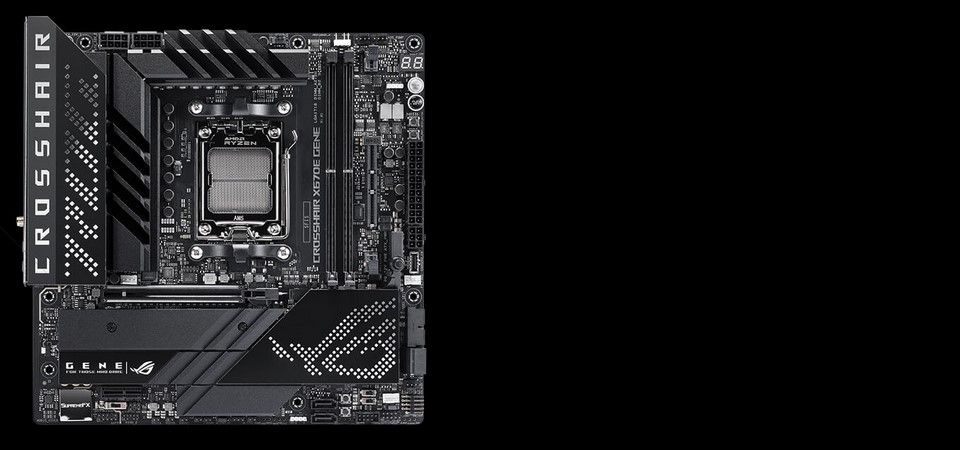
Headers
Thermal Management
An extensive array of headers line the ROG Crosshair X670E Gene for precise cooling control and monitoring.
Multiple Temperature Sources
Each header can be set to monitor and react to three user-configurable thermal sensors for workload-based cooling, and all settings can be easily managed by Fan Xpert 4 or UEFI.
4-Pin PWM/DC Fan Headers
Every onboard header auto-detects any PWM or DC fan.
AIO Pump
A dedicated PWM/DC header for self-contained water-cooling setups.
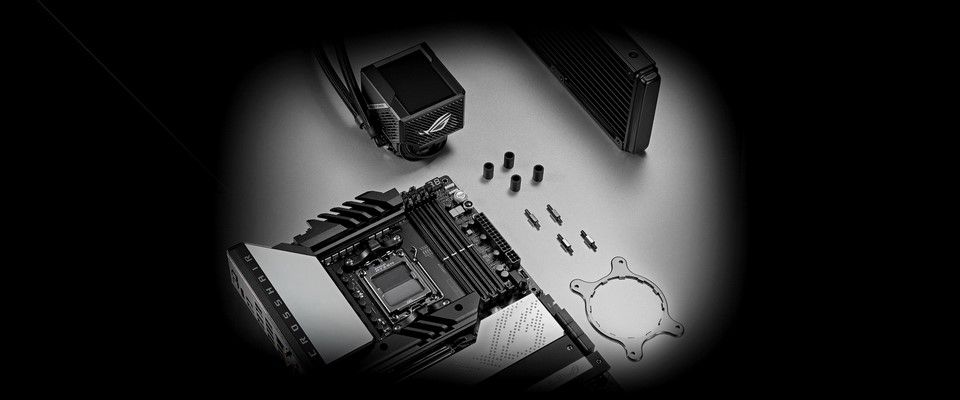
Compatibility
Cooler Compatibility
The ROG Crosshair X670E Gene bears the same mounting hole alignment as AM4 platforms, so it is backward compatible with many existing coolers, including all AIO offerings from ASUS and ROG.
Connectivity
Vast and fast. With PCIe 5.0 laced across the ROG Crosshair X670E Gene, loading and transfer times are nearly instantaneous. Plentiful USB lines the rear I/O, including two USB4® Type-C® ports capable of 40 GB/s speeds and 8K display output. Networking has a two-pronged attack with WiFi 6E and 2.5G LAN, and SupremeFX on-board audio keeps sound immersive and punchy.
PCIe 5.0
Fully embracing the new standard, the ROG Crosshair X670E Gene offers abundant Gen 5 support to give unfettered bandwidth to the fastest SSDs and graphics cards available.
Onboard M.2 Slot
The ROG Crosshair X670E Gene features an onboard M.2 slot that is PCle 5.0-ready to offer blistering 16 GB/s speeds.
ROG Gen-Z.2
The ROG GEN-Z.2 is the natural successor to the ROG DIMM.2 module. It inherits all the perks that made the original easy to install and use, and then raises the bar by adopting PCIE 5.0 on one slot and adding a suitably upgraded thermal solution to deal with the heat of nextgen drives.
Expansion Slot
The x16 expansion slot has undergone the PCle 5.0 treatment to offer incredible speeds up to 64 GB/s for compatible devices. To bear the brunt of massive graphics cards, itis also protected with Safeslot retention brackets, and can be easily released thanks to the Q-Release button.
USB Ports

USB 3.2 Gen 2x2 Type-C® Front-Panel Connector with Quick Charge 4+
USB 3.2 Gen 2x2 adds an additional lane that can boost Type-C data transfers with speeds of up to 20 Gbps. The port also features Quick Charge 4+ technology that can quickly charge devices up to 60W*.
* Requires a PCIe power supply cable to be plugged into the nearby 6-pin connector.
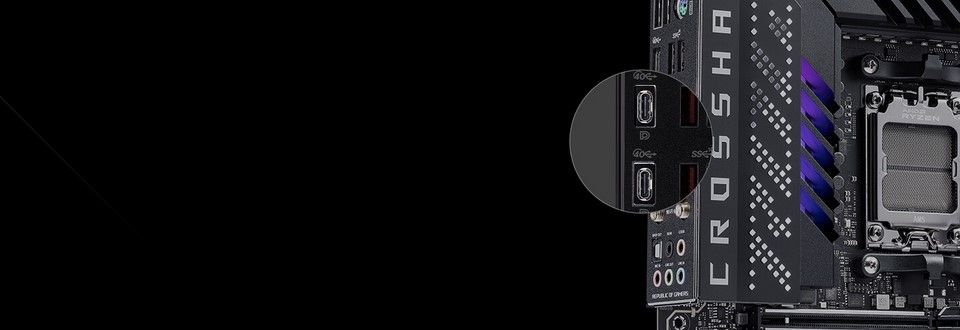
Two USB4® Type-C® Ports
Each USB4® port delivers up to 40 Gbps of bidirectional bandwidth for the latest super-speed devices and drives. External display support reaches up to 8K output if one of the ports is in use, or both can be employed for dual 4K displays.
Networking
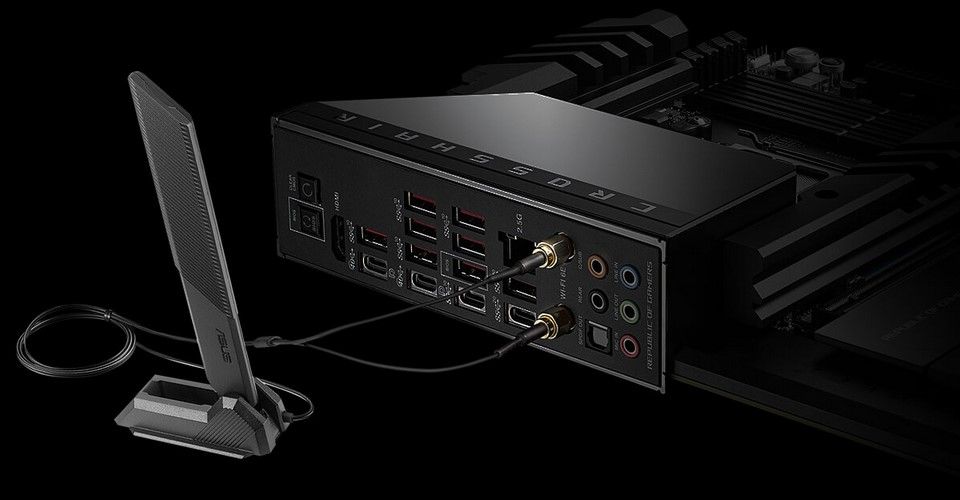
WiFi 6E
Onboard WiFi 6E technology takes advantage of newly available spectrum in the 6 GHz band to provide up to seven 160 MHz channels for ultrafast throughput and better performance in dense wireless environments.
*WiFi 6E availability and features are dependent on regulatory limitations and co-existence with 5 GHz WiFi.
WiFi 6E Antenna
The antenna has two built-in transmitters and receivers to enable faster transmission speeds, and it supports the 2.4,5 and 6 GHz bands
Magnetic Base
A powerful magnetic base secures the antenna on the top or side of the PC case.
Adjustable Design
Four-way positioning enables better signal reception.
Intel 2.5G Ethernet
Onboard Intel® 2.5 Gbps Ethernet gives your wired connection a boost, with speeds that are 2.5 times faster than standard Ethernet connections for speedy file transfers, smooth lag-free gaming and high-res video streaming.
Audio
SupremeFX
ROG SupremeFX is a unique blend of hardware and software that provides superior audio. In the ROG Crosshair X670E Gene, SupremeFX features the ALC4080 codec for immersive 384 kHz resolution audio across all channels. The front-panel output is streamed through a highly integrated Savitech amplifier that’s capable of driving a wide variety of gaming headsets and high-fidelity headphones.
Audio Line Shielding
Blocks electromagnetic interference from the motherboard or add-ons to provide cleaner audio.
Savitech SV3H712 Amplifier
The integrated Savitech amplifier greatly improves THD+N performance from -89 dB to -96 dB to deliver pristine audio quality.
ALC4080 Codec
Instead of the conventional high definition audio (HDA) interface, the ALC4080 codec uses a USB interface to deliver studio-level sound reaching up to 32-bit 384 kHz audio resolution.
Switching MOSFETS
Unique design allows the codec's impedance-sensing function to be ported with either the front or rear headphone outputs.
Capacitors
Fine-quality components that produce a warmer, natural sound with exceptional clarity and fidelity.
Optimization
A wealth of intuitive tools are at your fingertips so that you can optimize system performance quickly and efficiently while still having the flexibility to tinker to your heart’s content.
Intelligent Control
AI Cooling II
Balance the thermals and acoustics of any build with a single click. A proprietary ASUS algorithm slashes unnecessary noise while running a quick stress test, and then monitors CPU temperatures to dynamically adjust fans to optimal speeds.
Two-Way AI Noise Cancellation
This utility leverages a massive deep-learning database to reduce over 5 million types of background noise from incoming or outgoing audio, helping ensure crystal-clear communication in games or calls.
AI Networking
GameFirst VI optimizes networking performance by allocating bandwidth in real time based on application usage scenarios and corresponding learning algorithms.
AI Suite 3
The AI Suite 3 dashboard contains a set of intuitive controls that boost CPU performance while maintaining system stability.
CPU Performance Boost
The TurboV Processing Unit (TPU) is an intelligent onboard micro- controller that provides an array of system-tuning features, including the ability to fine-tune voltages, monitor system stats and adjust overclocking parameters.
Precise Digital Power Control
The Digit voltage-regulator module (VRM) delivers real-time control over voltage droop, switching frequency and power-efficiency settings allowing you to fine-tune CPU voltage regulation for ultimate stability and performance.
Turbo Core App
Modern processors feature per-core tuning, and the ASUS Turbo app makes use of this feature by letting you assign applications to specific processor cores, prioritizing computing power where it's needed most.
BIOS
UEFI BIOS
The renowned ROG UEFI (BIOS) provides everything you need to configure, tweak, and tune your rig. It offers intelligently simplified options for newcomers to PC DIY, as well as more comprehensive features for seasoned veterans.
Advanced Mode
When you're ready for a deeper dive, delve into the UEF'S Advanced mode and take complete control. Advanced mode enables full control over every aspect of the motherboard, and a built-in search function helps you quickly find the setting you need.
My Favourites
Quickly locate tuning options and add preferred tools to your favourites list.
EZ Flash 3
Flash the latest BIOS via the internet from within the BIOS.
S.M.A.R.T
Check your storage device Self-Monitoring, Analysis, and Reporting Technology (S.MART) logs to gauge reliability or to identify potential failures.
GPU Post
Automatically detect selected ASUS graphics cards to view detailed information.
Secure Erase
Restore your SSDs and NVMe storage to factory settings.
Last Modified Log
Track the last change and save preferred profiles to a USB drive. SATA Port Renaming Rename SATA ports for easy identification.
SATA Port Renaming
Rename SATA ports for easy identification.
ASUS User Profile
Port configuration settings between different BIOS versions or share them with friends
Q-Fan Control
Configure the fan's operating speed manually or use pre-configured Standard, Silent, Turbo, or Full Speed modes. By default, System fans will automatically switch to full speed if the temperature reaches 75° C.
EZ Mode
Designed to simplify setup, EZ mode presents vital settings and stats on a single page. With guided wizards, drag and-drop functionality, and one click application of important settings, your rig will be up and running in no time.
Intuitive Graphical Fan Controls
Fine-tune individual fans simply by dragging a curve with the mouse.
Storage Information
View SATA port details for easy device recognition.
Fast and Easy Clock Adjustment
Use the mouse to quickly change time and date settings
Aura On/Off Mode (Stealth)
Easily enable or disable Aura RGB lighting or every onboard LED, for a more subdued aesthetic.
Differential Sensing
Accurate Voltage Monitoring
Conventional motherboards use single-ended sensing tapped from a location that isn't ideal, leading to a large disparity between the actual voltage fed to the CPU and the value reported to software. The ROG Crosshair X670E Gene features a differential-sensing circuit and delicate IC that simplify overclocking and tuning by allowing you to track voltages more accurately.
Personalization
The powerful core of the ROG Crosshair X670E Gene is graced by reflective plating across the board, contrasted by a dash of lighting that shines between grooves in the VRM heatsink. Sync the RGB glow with your other gear through Armoury Crate to bring out the unique personality of your build.
Aura Sync
Grow Your Gaming World with Aura Sync
Up your game with complementary Aura Sync enhanced aesthetics, featuring preset lighting effects that can be easily synchronized across compatible ROG graphics cards, monitors, keyboards, and mice to give your setup a unified look.
- Static
- Breathing
- Strobing
- Rainbow
- Colour cycle
- Starry night
- Music effect
- Smart
- Adaptive colour
- Dark
Armoury Crate
Armoury Crate is a software utility designed to give you centralized control of supported gaming products, making it easy to tune the look and feel of your system. From a single intuitive interface, Armoury Crate helps you customize RGB lighting and effects for compatible devices and synchronize them with Aura Sync to create a unified lighting scheme across your system. In addition, Armoury Crate’s Fan Xpert4 tool provides comprehensive control over fans, water pumps and all-in-one (AIO) coolers.
You can also use Armoury Crate to download drivers, software and user manuals, register products, and tap into a special news feed that connects you to the global ASUS gaming community.
- Aura Sync
- Device
- Tool
- Fan Control
- Gaming News Highlight
- ASUS Account Management
Gaming Audio
Sonic Studio III
Sonic Studio supports HRTF-based (head-related transfer function(A head-related transfer function is an audio algorithm derived from sound data recorded through a dummy head. Test tones are played from a spherical grid around the dummy head to obtain subtle changes in sounds that come from different directions. The results are combined into an algorithm that allows Sonic Studio's virtual surround to process sound true to life.)) virtual surround for headsets, casting an immersive aural landscape that draws you deeper into the action. The intuitive Sonic Studio interface also offers a range of EQ options and one-click presets, allowing you to tailor acoustics to suit personal preferences or the characteristics of your headset.
Sonic Studio Link
Easily apply Sonic Studio effects on all playback devices. Simply press the Sonic Studio Link button to enjoy the effect on any playback device
App-Specific Profiles
Apply customized audio settings to different applications, so everything you do is perfectly tuned to the way you want to listen.
Sonic Studio Virtual Mixer
Combine audio output from selected apps with audio from the microphone input and stream the compiled mix.
DTS : Sound Unbound
Through the pre-loaded DTS® Sound Unbound™ app, the ROG Crosshair X670E Gene envelops you in rich audio, conjuring whole new levels of immersion for extraordinary gaming and entertainment experiences. By exploiting Microsoft spatial sound technology, DTS Sound Unbound creates an audial 3D space — putting you right in the middle of the soundscape, where you can sense the location and direction of every gunshot, footstep, or other sound in your virtual environment.
* DTS Sound Unbound requires in-game support. Check with developers for supported titles.
- Stereo Sound
- Surround Sound
- Spatial Sound
AIDA64 Extreme
The ROG Crosshair X670E series includes a one-year AIDA64 Extreme subscription, a tool that provides detailed information about hardware and software, as well as benchmarks to measure the performance of the entire system or individual components. AIDA64 Extreme includes a monitoring and diagnostics feature to detect and prevent hardware issues. All vital system sensors can be tracked in real time, allowing voltage readings, fan speeds, and temperature information to be displayed on the desktop or sent to dedicated displays or to the LCD panels of ROG AIO liquid coolers(Support available for ROG Ryujin II and later models.).
- ROG x AIDA64 Extreme
- Hardware Monitor Display
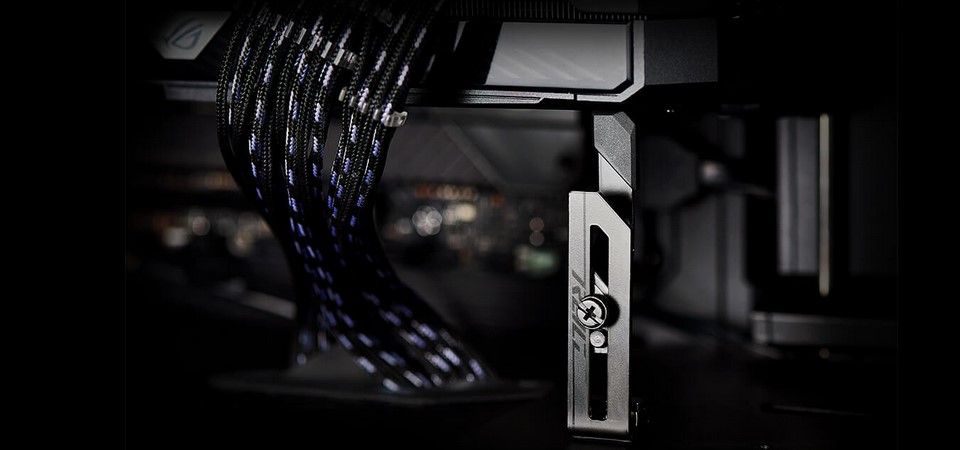
Graphic Card Holder
Featuring a magnetic base and adjustable slider and hinge, the ROG Graphics Card Holder banishes sag and provides support where it’s needed most.
This Changes Everything.
From this New Platform, You Can See the Future
- Build your next rig with an AMD Ryzen™ 7000 Series processor and ROG Strix X670E-A Gaming WiFi to experience advanced performance. With up to 16 “Zen 4” cores and 32 threads, boost clocks of up to 5.7GHz, and 80MB cache, the AMD Ryzen™ 7000 Series keeps you ahead of the game.
- You’ll also gain access to new features for gamers with AMD Socket AM5, from the speed of DDR5 memory to the increased bandwidth of PCIe® 5.0. AMD Ryzen™ 7000 Series processors and AMD socket AM5 motherboards are unlocked for overclocking to personalize your experience. Gain even more performance when you overclock your DDR5 memory with AMD EXPO™ technology.
Specifications
| CPU | AMD Socket AM5 for AMD Ryzen™ 7000 Series Desktop Processors Refer to www.asus.com for CPU support list. |
| Chipset | AMD X670 |
| Memory | 2 x DIMM, Max. 64GB, DDR5 6400+(OC)/6200(OC)/6000(OC)/5800(OC)/5600(OC)/5400(OC)/5200/5000/4800 ECC and Non-ECC, Un-buffered Memory Dual Channel Memory Architecture Supports AMD EXTended Profiles for Overclocking (EXPO™) OptiMem II Supported memory types, data rate(Speed), and number of DRAM module vary depending on the CPU and memory configuration, for more information refer to www.asus.com for memory support list. Non-ECC, Un-buffered DDR5 Memory supports On-Die ECC function |
| Graphics | 2 x USB4® ports support USB Type-C® display outputs VGA resolution support depends on processors' or graphic cards' resolution. |
| Expansion Slots | AMD Ryzen™ 7000 Series Desktop Processors 1 x PCIe 5.0 x16 slot AMD X670 Chipset 1 x PCIe 4.0 x1 slot Please check PCIe bifurcation table in support site (https://www.asus.com/support/FAQ/1037507/). |
| Storage | Total supports 3 x M.2 slots and 4 x SATA 6Gb/s ports AMD Ryzen™ 7000 Series Desktop Processors M.2 slot (Key M), type 2242/2260/2280 (supports PCIe 5.0 x4 mode) GEN-Z.2_1 slot (Key M) via GEN-Z.2, type 2242/2260/2280/22110 (supports PCIe 5.0 x4) AMD X670 Chipset GEN-Z.2_2 slot (Key M) via GEN-Z.2, type 2242/2260/2280/22110 (supports PCIe 4.0 x4) 4 x SATA 6Gb/s ports AMD RAIDXpert2 Technology supports both NVMe RAID 0/1/10 and SATA RAID 0/1/10. Performance may vary depending on the SSD's firmware version and the system hardware & system configuration, for more information refer to www.asus.com for device support site. |
| Ethernet | 1 x Intel® 2.5Gb Ethernet ASUS LANGuard |
| Wireless & Bluetooth | Wi-Fi 6E 2x2 Wi-Fi 6E (802.11 a/b/g/n/ac/ax) Supports 2.4/5/6GHz frequency band Bluetooth v5.2 WiFi 6E 6GHz regulatory may vary between countries, and function will be ready in Windows 11 or later. |
| USB | Rear USB (Total 10 ports) 2 x USB4® ports with Intel® JHL8540 USB4® controller (2 x USB Type-C®) 6 x USB 3.2 Gen 2 ports (5 x Type-A + 1 x USB Type-C®) 2 x USB 2.0 ports (2 x Type-A) Front USB (Total 7 ports) 1 x USB 3.2 Gen 2x2 connector (supports USB Type-C® with up to 60W PD/QC4+) 1 x USB 3.2 Gen 1 headers supports additional 2 USB 3.2 Gen 1 ports 2 x USB 2.0 headers support additional 4 USB 2.0 ports To support 60W, please install the power cable to the 6-pin PCIe Graphics Card connector or else only 27W can be supported. |
| Audio | ROG SupremeFX 7.1 Surround Sound High Definition Audio CODEC ALC4080 - Impedance sense for front and rear headphone outputs - Supports: Jack-detection, Multi-streaming, Front Panel Jack-retasking - High quality 120 dB SNR stereo playback output and 113 dB SNR recording input - Supports up to 32-Bit/384 kHz playback Audio Features - SupremeFX Shielding Technology - Savitech SV3H712 AMP - Gold-plated audio jacks - Rear optical S/PDIF out port - Premium audio capacitors - Audio cover |
| Back Panel I/O Ports | 2 x USB4® ports with Intel® JHL8540 USB4® controller (2 x USB Type-C®) 6 x USB 3.2 Gen 2 port(s) (5 x Type-A + 1 x USB Type-C®) 2 x USB 2.0 ports (2 x Type-A) 1 x Wi-Fi Module 1 x Intel® 2.5Gb Ethernet 5 x Gold-plated audio jacks 1 x Optical S/PDIF out port 1 x BIOS FlashBack™ button 1 x Clear CMOS button 1 x PS/2 Keyboard/Mouse combo port |
| Internal I/O Connectors | Fan and Cooling related 1 x 4-pin CPU Fan header 1 x 4-pin CPU OPT Fan header 1 x 4-pin AIO Pump header 1 x 4-pin Chassis Fan header 3 x 4-pin Full Speed Fan headers Power related 1 x 24-pin Main Power connector 2 x 8-pin +12V Power connector 1 x 6-pin PCIe Graphics Card connector Storage related 1 x M.2 slots (Key M) 1 x Gen-Z.2 slot supports 2 x M.2 slots (Key M) 4 x SATA 6Gb/s ports USB 1 x USB 3.2 Gen 2x2 connector (supports USB Type-C®) 1 x USB 3.2 Gen 1 header supports additional 2 USB 3.2 Gen 1 ports 2 x USB 2.0 headers support additional 4 USB 2.0 ports Miscellaneous 1 x 80 Light Bar jumper 2 x Addressable Gen 2 headers 1 x Alteration Mode Switch 1 x Aura RGB header 2 x BCLK button 1 x FlexKey button 1 x 10-1 pin Front Panel Audio header (AAFP) 1 x LN2 Mode jumper 1 x Osc sence header 12 x ProbeIt Measurement Points 1 x ReTry button 1 x RSVD switch 1 x RSVD header 1 x Safe Boot button 1 x Slow Mode switch 1 x Start button 1 x 10-1 pin System Panel header 1 x Thermal Sensor header |
| Special Features | Extreme OC Kit - FlexKey button - LN2 Mode - ProbeIt - ReTry button - Safe boot button - Start button - Slow Mode Extreme Engine Digi+ - 10K Black Metallic Capacitors - MicroFine Alloy Choke ASUS Q-Design - M.2 Q-Latch - PCIe Slot Q-Release - Q-Code - Q-Connector - Q-DIMM - Q-LED (CPU [red], DRAM [yellow], VGA [white], Boot Device [yellow green]) - Q-Slot ASUS Thermal Solution - M.2 heatsink backplate - M.2 heatsink - VRM heatsink design ASUS EZ DIY - BIOS FlashBack™ button - Clear CMOS button - ProCool II - Pre-mounted I/O shield - SafeSlot - SafeDIMM Aura Sync - Aura RGB header - Addressable Gen 2 headers Front Panel USB 3.2 Gen 2x2 with Quick Charge 4+ Support - Support: up to 60W charging - Output: 5/9/15/20V max. 3A, PPS:3.3–21V max. 3A - Compatible with QC 4.0/3.0/2.0, PD3.0 and PPS To support 60W, please install the power cable to 6-pin PCIe Graphics Card connector or can only support 27W |
| Software Features | ROG Exclusive Software - GameFirst VI - ROG CPU-Z - ROG True Voltician - Sonic Studio III + Sonic Studio Virtual Mixer + Sonic Suite Companion - Sonic Radar III - DTS® Sound Unbound - BullGuard Internet Security (1-year full version) ASUS Exclusive Software Armoury Crate - AIDA64 Extreme (1 year full version) - Aura Creator - Aura Sync - Fan Xpert 4 with AI Cooling II - Power Saving - Two-Way AI Noise Cancellation AI Suite 3 - TPU - DIGI+ Power Control - Turbo app - PC Cleaner MyAsus WinRAR UEFI BIOS ASUS EZ DIY - ASUS CrashFree BIOS 3 - ASUS EZ Flash 3 - ASUS UEFI BIOS EZ Mode |
| BIOS | 256 Mb Flash ROM, UEFI AMI BIOS |
| Manageability | WOL by PME, PXE |
| Accessories | Cables 1 x RGB extension cable 2 x SATA 6Gb/s cables ROG GEN-Z.2 with Heatsink 1 x ROG GEN-Z.2 with heatsink 1 x M.2 pad for ROG GEN-Z.2 2 x M.2 screw package for ROG GEN-Z.2 ROG True Voltician 1 x ROG True Voltician 4 x cables for ROG True Voltician Additional Cooling Kit 1 x Thermal pad for M.2 Miscellaneous 1 x ASUS Wi-Fi moving antennas 1 x Q-connector 1 x M.2 Q-Latch package for M.2 backplate 1 x ROG Graphics card holder 1 x ROG key chain 1 x ROG stickers 1 x ROG thank you card 1 x Rubber Package for M.2 backplate Installation Media 1 x USB drive with utilities and drivers Documentation 1 x User guide |
| Operating System | Windows® 11 64-bit, Windows® 10 64-bit |
| Form Factor | micro-ATX Form Factor 9.6 inch x 9.6 inch (24.4 cm x 24.4 cm) |







